#ancient romans
Text

Thomas Couture (1815-1879)
"The Romans in their Decadence" (1847)
Oil on canvas
Located in the Musée d'Orsay, Paris, France
#paintings#art#artwork#history painting#ancient rome#thomas couture#oil on canvas#fine art#musee d'orsay#museum#art gallery#french artist#ancient romans#decadence#decadent#indulgence#costume#costumes#1840s#mid 1800s#mid 19th century#aesthetic#aesthetics
203 notes
·
View notes
Text

Romulus and Remus by Joseph Binder
#romulus#remus#art#roman mythology#ancient rome#ancient romans#rome#roman#romans#founding#wolf#lupa#faustulus#sheperd#history#mythology#mythological#europe#european#antiquity#kingdom#twins#twin brothers#brothers#joseph binder#lupercal#she wolf#river tiber#lupa capitolina#capitoline
747 notes
·
View notes
Text
Once again inspired by @just-late-roman-republic-things.
Unarmed Ancient Romans in a Haunted House
(It's a good things swords aren't allowed.)
Octavian: He wasn't feeling well when this was proposed but insists on coming, then screams at the jump scares and somehow ends up hiding in a field next door.
Agrippa: He heads through and has no reaction at all to the scares. On the way through he sees a door hanging off its hinges and pulls out his all purpose tool to fix it. If Octavian is still hiding in the field when he exits, he goes to find him.
Mark Antony: He is laughing at most of the scares and chatting with the scare workers. If one manages to startle him, they get punched in the face, but they all go out for beers afterwards so it's cool. (If he gets outside before Agrippa, he goes to get Octavian out of the field with a big sigh. He does tease him about this.)
Lepidus: He is a cautionary tale and becomes the subject of local legends as he reluctantly went into the haunted house after Antony and Octavian told him to, but he never leaves. Some say on late nights, you can hear a voice crying in the night, "Why did I think we were a trio?"
Cicero: He explains to his group the psychology and special effects behind the haunted house as they go through it. Yes, he shrieks at a jump scare, but then immediately says, "Ah, see, the startle scare activates one's sympathetic nervous system and triggers an acute stress response that prepares the body to engage in either fight or flight." His group might not enjoy this, but Cicero does.
Dolabella: He is one of the scare actors and absolutely takes it too far with his act. He is the one punched by Antony.
Julius Caesar: Let's be honest, he just bought tickets for his friends and supporters who wanted to go... But if pressed, would absolutely be the guy talking about how it was not going to be scary in line so the scare actors decide to gang up on him throughout the entire thing and make his experience miserable.
Pompey: He boasts even louder than Caesar about how he is unable to be scared. That leads to a gang of scare actors picking on him as well until he runs out screaming, but once outside he pretends he was laughing the entire time.
Crassus: He stays outside and partners scared looking people with a group of large, brave people working for him for a nominal fee. Haunted house escort service. Not THAT kind. (That costs extra.)
Brutus: He manages to get through the house, finding the attitudes of Julius Caesar and Magnus Pompey as horrifying as anything inside the house. (Except for the clowns. They are admittedly worse.)
#ancient memes#inspired by @just-late-roman-republic-things#I just had to make another seasonal one#ancient romans#ancient romans in situations#octavian#agrippa#mark antony#marcus antonius#lepidus#Cicero#publius cornelius dolabella#julius cassar#magnus pompey#marcus licinius crassus#marcus junius brutus#lepidus is always going to just disappear in these#Octavian's was inspired by his hiding in a marsh during the philipics#and antony did actually save his bacon a few times#although we all know agrippa was Octavian's main rescuer when he needed it#and yes eventually he was quite capable at battle it is just fun to tease#ancient roman memes
69 notes
·
View notes
Text
"Rational Marius"

It doesn't get much more RATIONAL than Marius reading Latin by the light of an ancient Roman oil lamp. Based off the prompt "Marius, Rational" for Marius Appreciation Week.
#iwtv#interview with the vampire#vampire chronicles#marius de romanus#marius de romanus appreciation week#ancient rome#ancient romans
80 notes
·
View notes
Text
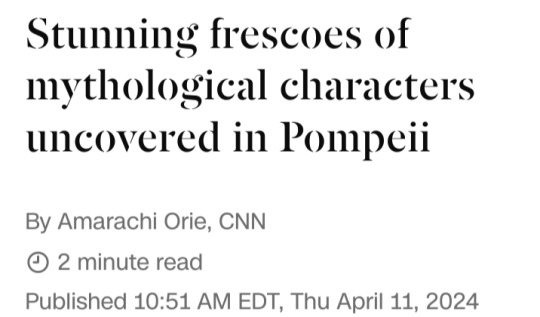


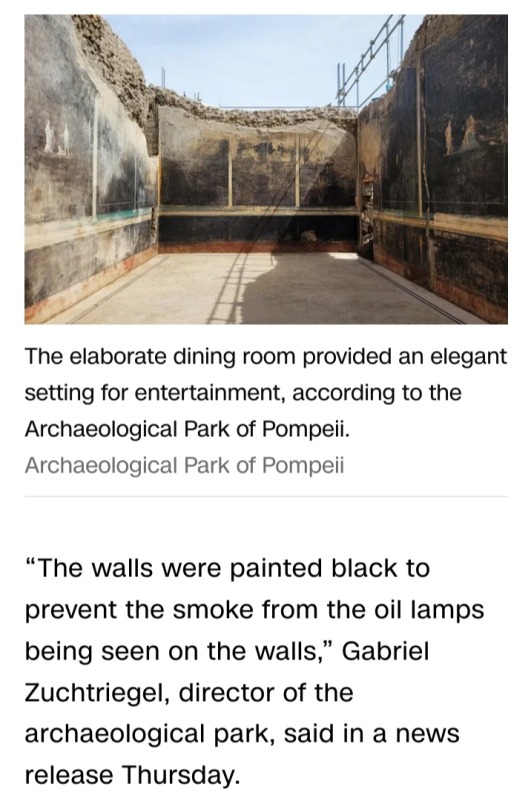






#Pompeii#Ancient Romans#frescoes#Apollo#Cassandra#King Priam of Troy#banquet halls#Archaeological Park of Pompeii#Helen#Paris#Menelaus#Trojan War#Mount Vesuvius#79 CE#excavation#archaeology
22 notes
·
View notes
Text

#cicero#classics#ancient romans#roman classics#roman history#marcus tullius cicero#Oratory#Rhetoric#classical civilisation#classical history#ancient rome#rome#Roman classics#Cicero's letters#Roman law courts#roman politics#Politics of the late republic#caesar#julius caesar#cato the younger#Verres#cicero the orator#Rome BC#history#Roman wars#Roman civil wars#marcus antonius#mark antony#roman oratory#roman rhetoric
61 notes
·
View notes
Text
Guys I need to draw some ancient Romans for this one thing but I don't know who to draw.
#pls reblog#i want to see some answers#ancient rome#tagamemnon#ancient romans#vergil#virgil#cicero#agrippina the younger#livia#octavia#emperor augustus#mark antony#julius caesar#julia the elder
24 notes
·
View notes
Text

Guess you could never say, the ancient Celtic people ever went over their heads!
💀😂💀
#history#ancient celts#heads#family heirloom#skulls#ancient#celtic history#gaul#ancient romans#france#ancient practices#european history#celtic#ancient culture#celtic mythology#ancient history#spooky facts#classical age#french history#ancient warfare#cedar oil#history mystery#nickys facts
8 notes
·
View notes
Text
Introduction to Latin: The Basics for Beginners
Introduction
Latin, the ancient language of the Romans, continues to enchant and educate people worldwide. Its influence on languages, literature, and legal systems is undeniable. For beginners eager to embark on the fascinating journey of learning Latin, understanding its grammar, vocabulary, and pronunciation is the first step. This post will guide you through these fundamental aspects, providing a solid foundation for your Latin learning adventure.
Understanding Latin Grammar
Latin grammar may seem daunting at first, but it's quite systematic. One of the language's distinctive features is its use of inflections. Words change their form (inflect) based on their role in a sentence. This is crucial for understanding Latin since word order is more flexible than in English.
Nouns and Cases
Latin nouns are categorized into groups called declensions. Each noun has a gender (masculine, feminine, or neuter) and is declined according to case and number. There are five main cases in Latin - Nominative, Genitive, Dative, Accusative, and Ablative - each serving a different syntactical purpose. For instance, the Nominative case is typically used for the subject of the sentence, while the Accusative is often the direct object.
Verbs and Conjugations
Latin verbs are conjugated to express tense, mood, voice, number, and person. There are four primary conjugations in Latin, and verbs are grouped into these based on the ending of their second principal part (the infinitive). Learning to conjugate verbs is essential for forming sentences and expressing various actions and states of being.
Adjectives and Agreement
Adjectives in Latin must agree with the nouns they describe in gender, number, and case. This agreement is vital for sentence clarity and coherence.
Building Latin Vocabulary
Expanding your Latin vocabulary is a mix of memorization and recognition of patterns. Many Latin words are the ancestors of English terms, especially those in scientific, legal, and literary contexts. Start with common nouns, verbs, and adjectives, and use flashcards or apps to reinforce your learning. Practice by translating simple sentences from English to Latin and vice versa.
Mastering Latin Pronunciation
Classical Latin pronunciation is somewhat different from the Ecclesiastical (Church) Latin used in religious contexts. Here's a brief guide to classical pronunciation:
Vowels are pronounced more distinctly than in English, with 'a' as in "father," 'e' as in "they," 'i' as in "machine," 'o' as in "fort," and 'u' as in "flute."
Consonants are generally pronounced as in English, but 'v' is pronounced as 'w,' and 'c' and 'g' are always hard, as in "cat" and "get."
Diphthongs like 'ae' and 'oe' are pronounced as 'ai' in "aisle" and 'oi' in "oil," respectively.
Conclusion
Embarking on the journey of learning Latin is not just about mastering a language; it's about connecting with centuries of history, literature, and culture. By grasively embracing Latin's grammar, diligently building your vocabulary, and accurately mastering pronunciation, you're setting a strong foundation for your Latin studies. With patience and practice, you'll unlock the rich and rewarding world of Latin texts and traditions. So, take a deep breath, dive in, and let the language of the ancients guide you through a transformative learning experience.
4 notes
·
View notes
Text
Random Fact #6,441
Ancient Greek and Roman sculptures were originally brightly painted, often in styles that would seem garish by modern standards.


#ancient romans#ancient rome#ancient greece#ancient greeks#did you know#little known fact#random factoids#random factoid#random fact#random facts#art history#history facts#history#greece#italy
23 notes
·
View notes
Text
The Secret History
Pg. 41 lines 28-31
“Easy to see why the Romans, usually so tolerant of foreign religions, persecuted the Christians so mercilessly—how absurd to think a common criminal had risen from the dead, how appalling that his followers celebrated him by drinking his blood.”
🤭 GWORLL Julian did not just call Jesus a common criminal LMFAOO
7 notes
·
View notes
Text

This reminds me of that polish dictionary with definitions like
Horse: everyone knows what a horse is
#science#language#ancient romans#ancient history#ancient civilizations#ancient egypt#ancient architecture
3 notes
·
View notes
Text

The Lictors Bring to Brutus the Bodies of His Sons
by Jacques-Louis David
#jacques louis david#art#ancient rome#neoclassical#lucius junius brutus#titus junius brutus#tiberius junius brutus#vitellia#brutus#sons#roman#romans#rome#antiquity#europe#european#history#roman republic#ancient romans#stoicism
75 notes
·
View notes
Text

This fresco discovered in Pompeii may look like a 2,000-year-old pizza but archaeologists say it can't be — tomatoes weren't grown in Italy at the time.
Still, excavations of the city preserved in volcanic ash have yielded fascinating insights into what Pompeiians truly did eat.
📷: Abaca Press / Alamy
#Mount Vesuvius#Pompeii#79 A.D#Pompeii Archaeological Park#archaeological site#Ancient Romans#Archaeology#Archeology#volcanic eruption
7 notes
·
View notes
Text
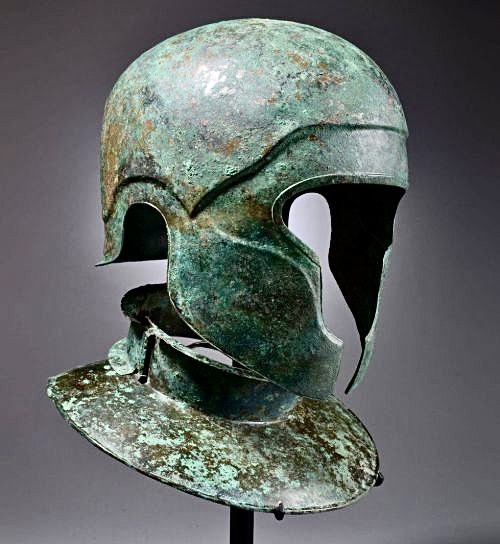
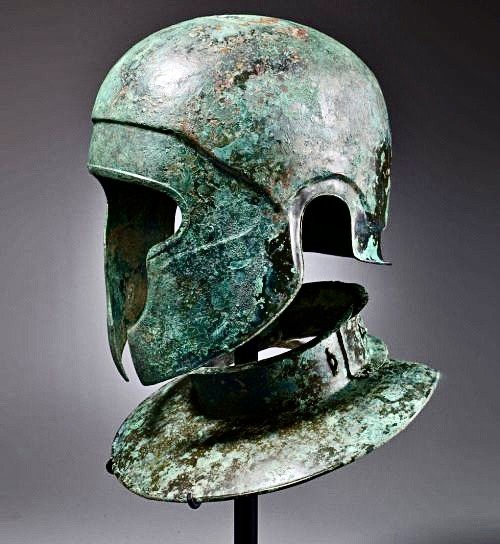
Samnite Bronze Helmet and Neckguard, C. 450 BC
This imposing helmet is a unique hybrid of the Samnite-Chalcidian type.
The Samnites were an Italic people living in Samnium (see Wikipedia article map, below) in south-central Italy who fought several wars with the Roman Republic. They formed a confederation, consisting of four tribes: the Hirpini, Caudini, Caraceni, and Pentri. They were allied with Rome against the Gauls in 354 BC, but later became enemies of the Romans and were soon involved in a series of three wars (343–341, 327–304, and 298–290 BC) against the Romans. Despite a spectacular victory over the Romans at the Battle of the Caudine Forks (321 BC), the Samnites were eventually subjugated.
What was known as a ‘Samnite Gladiator’ appeared in Rome shortly after the defeat of Samnium in the 4th century BC, apparently adopted from the victory celebrations of Rome’s allies in Campania. By arming low-status gladiators in the manner of a defeated foe, Romans mocked the Samnites and appropriated martial elements of their culture.

Samnite soldiers 330s BC depicted in a tomb frieze in Nola, Southern Italy.
Collection: Naples Archaeological Museum
Source/Photo: Shonagon 2022-04-28
Wikipedia ref: Samnites
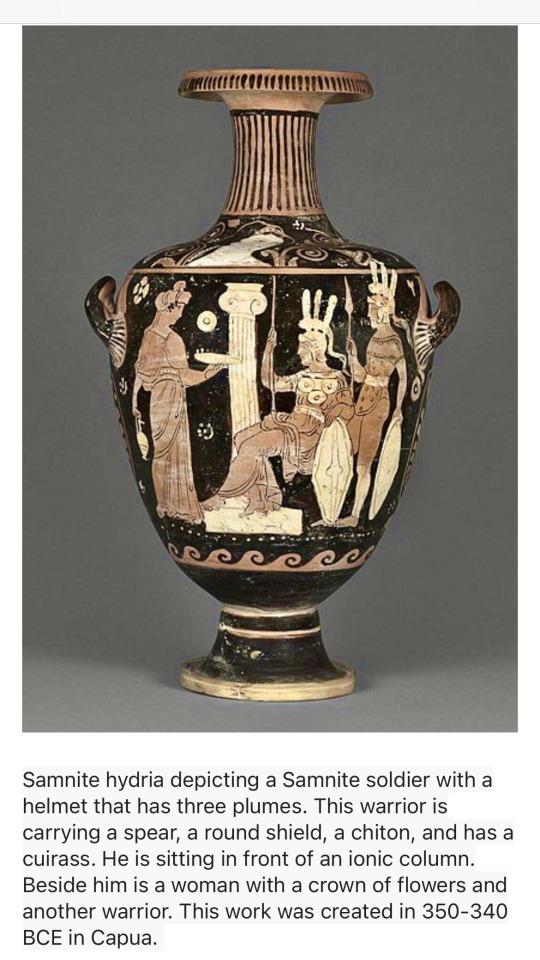
Collection: Louvre Museum, Department of Greek, Etruscan and Roman Antiquities
Wikipedia ref: Samnites
#Samnites#Gladiator#Ancient body armour#Ancient helmet#Ancient neckguard#Ancient Romans#Samnite wars#Ancient Samnites#Antiquities#Stone antiquities#Metal antiquities#Bronze antiquities#Pottery & ceramic antiquities
2 notes
·
View notes
Text
The Eagles of Rome by Enrico Marini is an example of the great historical fiction comics the European comic scene has to offer. This is my review.

One of the things I love about European comics is the number of great historical fiction titles available. So, I thought I share a review I did of one of my favorites: The Eagles of Rome.
The Eagles of Rome, by Enrico Marini, is set in the The Roman Empire in the first century AD, during the reign of Emperor Augustus. Rome is seeking to expand its boarders into Germania. Towards this end, a young Germanian prince has been sent to Rome to be fostered as part of a peace agreement with the Cherusci tribe. To his people he is Ermanamer, but the Romans have given him a new name: Arminius. Arminius has been sent to live with Titus Valerius Falco and his son Marcus. The comic follows Arminius and Marcus as the grow into men and join the legion. As they grow, Arminius finds himself increasingly drawn to the land of his birth. Marcus and Arminius are going to find themselves on opposite sides of a great conflict. In time it will be known as the Battle of Teutoburg Forest.
The Eagles of Rome isn’t finished yet, as Marini writes and draws the comic all one his own. There’s usually a few years wait between volumes, but it is totally worth it. Marini takes his time to ensure a quality comic. The comic is illustrated in gorgeous watercolor paintings, and you can tell Marini puts lots of love and care into his artwork.
The historical accuracy is rock solid as well. A few events are shifted around to make for better story flow, but otherwise it is all perfectly accurate to the historical record. The biggest bit of artistic license is that Marcus and his family are totally fictional. They’re mostly there to give the Roman perspective on things. Funnily enough, DC did this thing a few years back where they hired European comic writers to make comics based on iconic DC heroes. Marini wrote a Batman comic, and he drew Bruce Wayne almost exactly like Marcus.
There’s also little details that add to the historical accuracy. Statues and buildings are covered in vibrant colored paint, just as they were in Roman times. We also get to see the seedier parts of Rome and how, if you were poor, living in Rome was like living in a third world country.
I don’t know when the next issue is coming out, but I can’t wait to see what happens next. Have you read The Eagles of Rome? If so, what did you think?
Link to the full review on my blog is here: http://drakoniandgriffalco.blogspot.com/2019/07/comic-review-eagles-of-rome-vol-1-5-by.html?m=1
#comic books#graphic novel#The Eagles of Rome#enrico marini#ancient rome#Rome#roman empire#Romans#Ancient Romans#historical fiction#review#comics#comics review#graphic novel review#bande dessinée#european comics#europe comics#historical comics#comic book#graphic novels#Comic review#graphic novels review
3 notes
·
View notes